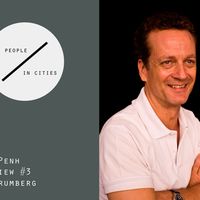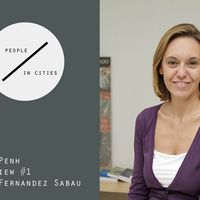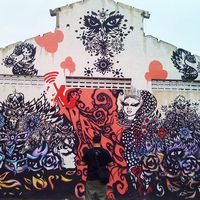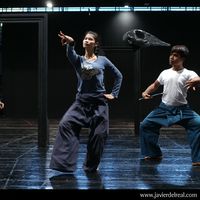By People / In Cities : Phnom Penh | city profile

By people / In cities is a series of articles and interviews that aims to enhance the understanding of art and culture in Southeast Asia through individual stories and perspectives including artists, cultural practitioners, and policy makers from the following 5 cities: Bangkok, Jogjakarta, Kuala Lumpur, Phnom Penh, and Singapore.
The second series introduces Phnom Penh, Cambodia, through its cultural heritage and the recent transformations that have been taking place at the intersection of traditional and contemporary practices. It will include interviews by Fred Frumberg (Director of Amrita Performing Arts), Maria Fernandez Sabau (Consultant, Lord), Mirana Randriananja (Communications Manager, Artisans Angkor), and Sophiline Shapiro (Dancer, Khmer Arts Ensemble.)
Like other cities that have been ravaged by war, Phnom Penh’s image is one that is haunted by the atrocities led by the Khmer Rouge, and the scars left both physically and psychologically in the city and within people’s minds. Before this tragic chapter of Cambodian history was written, Phnom Penh was once known in Khmer as Krong Chaktomuk meaning “the City of Four Faces” sitting at the junction where the rivers Mekong, Bassac, and Tonle cross to form an “X”. Today, Phnom Penh is a city in evolution with multiple faces, and which thrives to draw new chapters that can heal wounds, sustain collective memories of the past, revive its cultural heritage, and build toward a modern future based on local cultural assets.
Phnom Penh is a capital city of 2 million people, and has been experiencing urban modernisation although perhaps not at the same rate as its Asian neighbours. Its skyline shows cranes, and new buildings, however the city centre has kept its notorious human scale. Phnom Penh is also known as a base for a large number of foreign NGO’s notably in the arts and handicrafts sectors. Their presence have made local artists rather dependent on foreign structures due to scarce national government support.
"More support from the government for non-tangible culture (is needed) as well as a stronger sense of responsibility of the part of well off Cambodians who are in a situation to help develop the arts community. Nearly the entire burden now falls on international NGO’s and that needs to shift.” – Fred Frumberg, Director, Amrita Performing Arts
New wave
Many weaknesses in Phnom Penh have the potential to be turned into opportunities these days. In small pockets across the city, creative initiatives have been flourishing, contemporary art galleries been spreading (Sa Sa Bassac, Java Arts), festivals taken shape (Our City Festival), and new cultural ecosystems are quietly growing.
“New creative practices in Cambodia are often looking for their roots and connection with the country’s traditions (…) one of the challenges for contemporary Cambodian artists is to find room for self expression in a country where almost every artistic form has disappeared during the Khmer Rouge period (1975-1979).” – Maria Fernandez Sabau, Director of Lord
The gaping hole left by the war means that practically everything needed to be rebuilt practically from scratch. Hence, it is a new canvas but one that is riddled with stories from both the close and distant past, while simultaneously imbued by a wealth of traditional art forms. With a dominating conservative mindset, the true challenge for the next generation is to reconnect with their cultural heritage in new ways. How can traditional forms be re-interpreted through the creation of new content?
In the area of performing arts, Amrita works on the reconnection between past and present to shape a meaningful future for the next generation of artists. Together with organisation Cambodia Living Arts, they work with local schools to provide dance classes and foreign advisors are invited to bring their expertise in choreography and dramaturgy: two areas in which Cambodia is strongly lacking in terms of capacity. Most recently Belgian choreographer Arco Renz, Indonesian choreographer Eko Supriyanto, and Khmer/French choreographer Emmanuelle Phuon, led successful workshops.
“Amrita’s mission is to help revive and preserve the wide spectrum of Cambodia’s traditional performing arts through a programme that emphasized national capacity building in all aspects of project management. In its current phase of development, Amrita Performing Arts has become a major catalyst in helping these young artists find their voice and move their creative drives forward in a proactive, nurturing, and culturally sensitive environment.”
In need of local demand
Building an audience for performances can be a challenge for the long-term sustainable future of such groups. Amrita tours internationally and draws increasing interest from overseas. In the case of the Khmer Arts Ensemble, it has sometimes been difficult to generate revenue as most public dance performances in Cambodia are held for free. New target audiences have to be reached.
“I think our target paying audience is made up of three main groups. The first is middle class Cambodians who are educated and employed—either before they start having children or after their children are grown. The second group is expatriates living in Phnom Penh. The third would be tourists, though we don’t expect this group to ever be a significant portion of our audience.” – John Shapiro, Executive Director, Khmer Arts Ensemble
Cambodia is known as a cultural destination, and the side effects of tourism in Phnom Penh have had their consequences on local cultural industries both in a positive and negative manner. On the one hand, foreign attention has led to the emergence of new art form and content, led by a young generation working across different disciplines including visual arts, dance, and music. On the other, practices known as “cultural decoration” use arts and culture as pale reflections and diluted representations of local traditions. Tourism can be perceived a source of revenue for local artists, however it has a strong tendency to draw attention on lower quality content. The artificial productions that are conceived for foreign tourists compete with the culturally authentic. With the absence of policies protecting valuable assets, this type of practice is a threat to all artistic developments in the country.
The handicrafts sector also sees some challenges related to a changing society caught in the midst of a modernization process.
“The handicraft sector is in peril owing to the increasing number of factories and large scale agricultural projects – rubber, cassava – luring young workers away from the villages and looms; and also, amongst other factors, owing to the rising price of important silk yarn.” - Alan Flux, Design and Marketing Advisor, Artisans Association of Cambodia
Like in the rest of Southeast Asia, Phnom Penh is caught in between a dual process of recovering and preserving its own heritage while at the same time accelerating to catch up with the global marketplace. This is where a long-term vision is needed to develop local capacity and also boost local demand for the arts and culture.
Phnom Penh has one fine art school, the Royal University of Fine Arts (RUFA), enrolling about 1600 students; it is the only affordable art school in the whole of Cambodia. Over recent years, private schools from overseas have been spreading in the capital, however their tuition fees are far beyond reach for the average local citizen. The lack of educational infrastructure in the arts can be strongly felt among young generations. To choose a creative career is a risky path that is only taken by few. A traditional dancer makes on average US$ 50 per month, and many young talents turn to commercially more viable activities that are not exactly rooted in local culture.
Nevertheless, the recognition and appreciation for local art and culture has the possibility to be nourished through the expanding upper middle class.
“As much as Cambodia is an artistic country by nature, the work of arts and artists is not always recognized. There is a need to connect art forms with the general public in order to attract the number of patrons. There is an opportunity to connect the rapidly growing number of wealthy individuals and corporations in Phnom Penh with the increasing number of local creators.” – Maria Fernandez Sabau, Director of Lord
Evolution
As an urban creative platform experiencing rapid transformations and concerned about reclaiming its heritage for future generations, Phnom Penh is a city full of promise. It is gaining momentum in the region and starting to make an impression beyond its borders. Its many faces are the resounding voices for the past, present, and future. Phnom Penh’s path to recovery is also the path toward new opportunities that surely will be unlocked by artistic inspiration.
“It may be a bit ambitious to say that arts and culture alone are able to bring social change, but without doubt, they contribute to the evolution of mindsets.” Mirana Randriananja, Communications Manager, Artisans Angkor
--
- Read interview with Maria Fernandez Sabau (Lord Consulting/UNESCO)
- Read interview with Mirana Randriananja (Artisans d'Angkor)
--
By people / In cities is a series of articles and interviews that aims to enhance the understanding of art and culture in Southeast and East Asia through individual stories and perspectives including artists, cultural practitioners, and policy makers from the following 6 cities: Bangkok, Jogjakarta, Kuala Lumpur, Phnom Penh, Hong Kong and Singapore.
--
Image credits: Sali Sasaki
Similar content
16 Jan 2017
from - to
14 Jan 2012 - 29 Jan 2012






